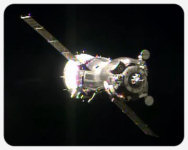 Last night’s Soyuz launch to the ISS with Karen Nyberg, Luca Parmitano and Fyodor Yurchikhin has made a new record, taking only 5 hours and 39 minutes from rocket ignition to the station. It was only the second time the faster launch method has been tried with astronauts on board, but it was a full success and the three new crewmembers did not have to endure nearly two days in the cramped Soyuz spacecraft like before. Now the ISS is again fully crewed with six people – the two NASA astronauts Karen Nyberg and Chris Cassidy, ESA astronaut Luca Parmitano and the three russian cosmonauts Pavel Vinogradov, Alexander Misurkin and Fyodor Yurchikhin.
Last night’s Soyuz launch to the ISS with Karen Nyberg, Luca Parmitano and Fyodor Yurchikhin has made a new record, taking only 5 hours and 39 minutes from rocket ignition to the station. It was only the second time the faster launch method has been tried with astronauts on board, but it was a full success and the three new crewmembers did not have to endure nearly two days in the cramped Soyuz spacecraft like before. Now the ISS is again fully crewed with six people – the two NASA astronauts Karen Nyberg and Chris Cassidy, ESA astronaut Luca Parmitano and the three russian cosmonauts Pavel Vinogradov, Alexander Misurkin and Fyodor Yurchikhin.
The star, so to speak, of the ISS Expedition 36 is Volare, the fifth long-term ESA mission to the station with italian astronaut Luca Parmitano. He is one of the newest and youngest astronauts inhabiting the space station – the former italian airforce pilot had only been selected in 2009 for a group of astronauts called The Shenanigans and his mission is his very first space flight. Both Karen Nyberg and Fyodor Yurchikhin have been in space before, the russian cosmonaut was even part of a long-term ISS mission in 2010.
Here are some links to the videos from the launch, docking and crew welcome:
• The launch from last evening – there’s also the complete ESA coverage.
• Approach & docking – spectacular views of the Soyuz at the station!
• Hatch opening, welcome and press conference – a really warm and even funny welcome.
Apart from the “official” channels, there’s also the ESA blog of Luca Parmitano’s Volare mission, where he also often writes himself. He’s also on twitter as @Astro_Luca as is Karen Nyberg as @AstroKarenN, who has already written a short first tweet from space – and I’m sure that Luca Parmitano will follow soon.
It’s going to be very busy on the ISS soon, not only because of all the science experiments – the station is going to be a real spaceport with ESA’s ATV transporter Albert Einstein arriving on 15 June, the first flight of Orbital Sciences’ Cygnus 1 following later that month and the Japanese HTV-4 and a Russian Progress freighter coming in August. The next Dragon transporter from Space X will fly in December and there will also be a whole new station block, the Russian Nauka Multipurpose Laboratory Module added to the ISS at the end of the year.